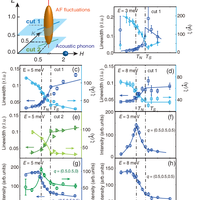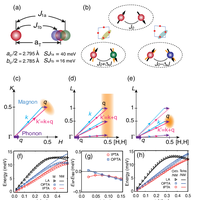Abstract
We use inelastic neutron scattering to study acoustic phonons and spin excitations in single crystals of NaFeAs, a parent compound of iron-pnictide superconductors. NaFeAs exhibits a tetragonal-to-orthorhombic structural transition at Ts≈58 K and a collinear antiferromagnetic order at TN≈45 K. While longitudinal and out-of-plane transverse acoustic phonons behave as expected, the in-plane transverse acoustic phonons reveal considerable softening on cooling to Ts and then harden on approaching TN before saturating below TN. In addition, we find that spin-spin correlation lengths of low-energy magnetic excitations within the FeAs layer and along the c axis increase dramatically below Ts and show a weak anomaly across TN. These results suggest that the electronic nematic phase present in the paramagnetic tetragonal phase is closely associated with dynamic spin-lattice coupling, possibly arising from the one-phonon-two-magnon mechanism.
Figures
Register to see more suggestions
Mendeley helps you to discover research relevant for your work.
Cite
CITATION STYLE
Li, Y., Yamani, Z., Song, Y., Wang, W., Zhang, C., Tam, D. W., … Dai, P. (2018). Dynamic Spin-Lattice Coupling and Nematic Fluctuations in NaFeAs. Physical Review X, 8(2). https://doi.org/10.1103/PhysRevX.8.021056

![FIG. 1. (a) Left: Schematics of the Fe layers in NaFeAs. Red spots represent Fe atoms, and the tetragonal (orthorhombic) unit cell is shown by the green (blue) shaded square. The middle and right panels are the two orthorhombic domains. The yellow and red areas are the tetragonal unit cells with opposite shear distortions. The arrows in the middle panel indicate the spin direction in the AF ordered phase. The orthorhombic lattice parameters are ao ¼ 5.589 Å and bo ¼ 5.569 Å. (b) A particular IPTA phonon mode with a momentum propagating horizontally to the right but with Fe atoms oscillating vertically. Here, λ is the size of the probing domain, and it is inversely related to q. (c) The three different equivalent positions in reciprocal space used in our neutron scattering measurements in order to determine all three acoustic phonon branches. The purple arrows with q are the momentum of the measured phonons along the ½H; 0; 0 direction, and the double-headed arrows represent the phonon polarizations along the a (red, LA), b (blue, IPTA), and c (green, OPTA) axes. (d) The corresponding dispersions of the three phonon modes at 100 K estimated from data in Ref. [37]. The inset shows an expanded view of the low-energy part of the dispersion.](https://s3-eu-west-1.amazonaws.com/com.mendeley.prod.article-extracted-content/images/25f2d991-fc51-33e2-84ed-f6e637299681/thumbnail-61e74d7f-3a54-49b3-84d2-d4fa1dee9703-0.png)


![FIG. 4. (a)–(d) Constant-E (E ¼ 2 meV) scans along the cut-3 direction as shown in Fig. 3(a) at 45 K, 50 K, 55 K, and 60 K. Background scans are obtained by measuring at q ¼ ð0.4; 0.4; LÞ and ð0.6; 0.6; LÞ and are subtracted from the raw data. The scan at 60 K is featureless. On cooling to 55 K, two weak peaks show up around L ¼ 0.5 r.l.u. Upon further cooling, these peaks become prominent at T ¼ 45 K. They disappear below TN due to the opening of a spin gap. The total magnetic scattering intensity increases on cooling. The solid lines are fits with a periodic Lorentz function [37]. (e)–(g) Temperature dependence of the linewidths and correlation lengths of the low-energy spin fluctuations along the c-axis direction [cut 3 in Fig. 3(a)] at 2 meV, 3 meV, and 5 meV. (h) Temperature dependence of the integrated intensity along the cut-3 direction at different energies [37].](https://s3-eu-west-1.amazonaws.com/com.mendeley.prod.article-extracted-content/images/25f2d991-fc51-33e2-84ed-f6e637299681/thumbnail-70844226-a9e8-407d-8d58-558a86926257-3.png)

